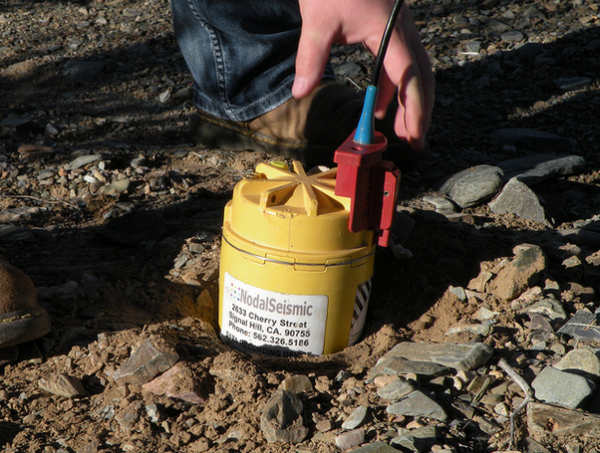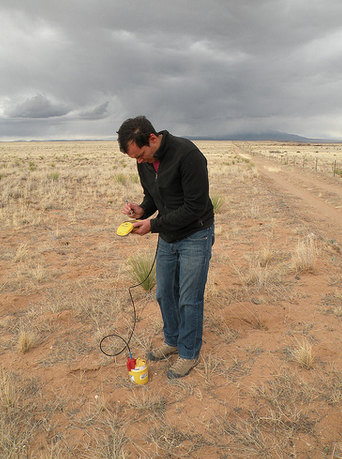Ensemble Cast Supports Socorro Magma Body Experiment
During February 2015, EPIC staff assisted Principal Investigators Sue Bilek, Rick Aster, Brandon Schmandt, and Lindsay Worthington with the installation of numerous single-channel nodes in conjunction with seven EPIC broadband stations (data) to image the Socorro Magma Body (SMB) beneath the Sevilleta National Wildlife Refuge in central New Mexico.
800 NodalSeismic nodes were installed over two days in the beginning of February 2015 by five teams comprised of EPIC and EarthScope staff, as well as students and faculty from the University of New Mexico, New Mexico Tech, and Colorado State University. The goal was to record natural seismicity (local, regional, and teleseismic); additionally, one day's worth of PEG-40 thumper shots were used for shallow structure imaging. Two weeks later the nodes were picked up over two more days, and then shipped back to NodalSeismic for downloading. Both the broadband and the nodal data will be studied intensely by project principal investigators and their students in the months to come; the data will be released to the public in one year.
Here follow some video and photographic highlights of the experiment.
 |
Deployment Area This map shows the seven broadband stations which were used in conjunction with the 800 Nodalseismic nodes. Six of the stations were in the Sevilleta National Wildlife Refuge; the southernmost station is near the EPIC facility in Socorro. Click on the image for a larger version. |
|
This map portrays how the 800 nodes were deployed around the existing broadband network. Click on the image for a larger version. |
 |
|
Socorro Magma Body—What it is and the monitoring strategy This 4:18 minute-long video is an animation of the seismic project. The Socorro Magma Body in New Mexico is the 2nd largest magma body within continental crust in the world. It is inflating the earth’s surface at a rate of about 1.5–2 mm/year, as measured since 1911. Dr. Susan Bilek, colleagues, and teams placed 7 broadband seismometers, plus a dense array 800 vertical-component seismometers to look at seismicity and deformation around the Socorro Magma Body. |
|
|
Socorro Seismic Deployment In this 2:52 minute-long video (published on Youtube on Feb 18, 2015), Dr. Susan Bilek describes the deployment of seismometers to look at the Socorro Magma Body. With project colleagues and students, they placed seven broadband seismometers, plus a dense array 800 vertical-component seismometers to look at seismicity and deformation around the magmatic intrusion. |
|
|
|
One of the purposes of the experiment was to compare data acquired with Nodalseismic nodes to data from traditional broadband sensors. Nodalseismic's cable-free nodes require almost no troubleshooting, and possess rigid, external shells that can endure extreme environments. Image © and courtesy of NodalSeismic. Learn more about NodalSeismic nodes here. |
|
Here, the teams are shown reviewing field maps and strategizing deployment options. L-R: Rick Aster, Lindsay Worthington, Sue Bilek, Jamie Hansen. |
 |
 |
More pre-deployment planning in the EarthScope/EPIC conference room. L-R: Conoly Lockett, Lloyd Carothers, Rich Rowland, Brandon Schmandt, Sue Bilek, Michael Johnson, Rick Aster, Lindsay Worthington |
|
Distribution of maps and node programming devices prior to deployment. L-R: Rich Rowland, Lloyd Carothers, Michael Johnson, T.C. West, Brandon Schmandt, Alissa Scire |
 |
 |
In the field: Conoly Lockett and Lindsay Worthington activate the programming of a node. |
|
Conoly Lockett and Lindsay Worthington are shown checking field notes for the station. |
 |
 |
A node from NodalSeismic being deployed. |
|
On the Sevilleta National Wildlife Refuge, looking towards the Manzano Mountains. |
 |
 |
Here, Conoly Lockett is shown deploying NodalSeismic sensors around an already-installed broadband seismic sensor from EPIC. |
|
This is a finished broadband station, with five collocated nodes. |
 |
 |
Conoly Lockett and Rick Aster, in deployment mode! |
|
Sturdy nodes, waiting for deployment... |
 |
 |
Sierra De La Cruz in Socorro County, NM |
|
North side of Turututu (aka Black Butte) |
 |
 |
South side of Turututu (aka Black Butte) |
|
Rick Aster is closing in on a station to be deployed using a specialized handheld GPS unit. |
 |
 |
Steve Bernsen deploys on the windy day. |
- Home
- General Information
- Instrumentation
- Dataloggers
- Sensors
- All-In-One Systems
- Power Systems
- Field Procedures
- Controlled Sources
- Seismic Source Facility
- Magnetotelluric Systems at EPIC
- Ground Penetrating Radar
- GNSS/GPS Receivers
- Power and Memory Calculations Form
- Data Archiving
- Apply for a PI Account
- Experiment Scheduling
- Polar
- Hardware & Software Notes
- Software


